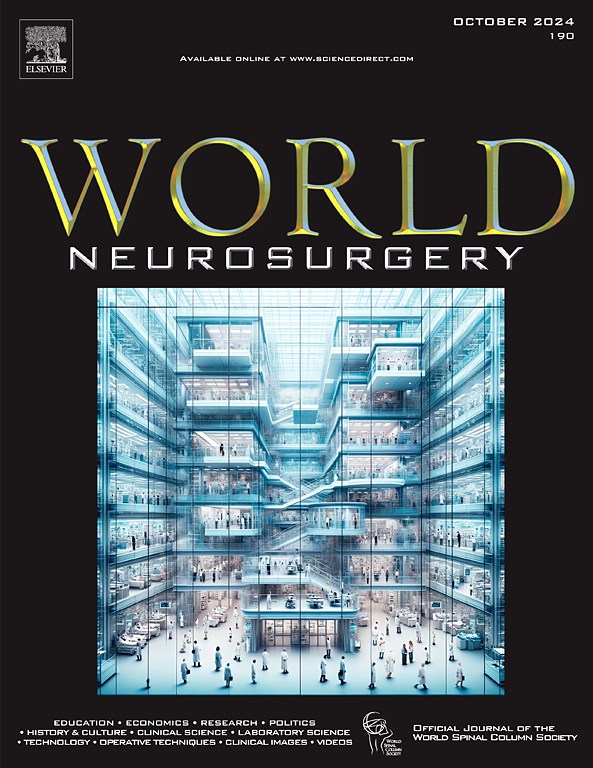先天性脊柱后部缺失:病例序列、文献回顾及分类建议。
IF 2.1
4区 医学
Q3 CLINICAL NEUROLOGY
引用次数: 0
摘要
目的:本文报道5例新发先天性椎后轴缺位(C2),文献报道共17例,并对这一罕见疾病提出解剖学分类体系,以规范其治疗。方法:回顾性分析2017年至2024年诊断并手术治疗的5例C2后椎体缺失患者。总结临床特征,并进行影像学研究,包括x射线,CT和MRI来确定异常和脊髓压迫。根据解剖特点和新分类选择手术入路。根据椎体脱位或不稳定将该罕见疾病分为ⅰ型(C2/3单节段)和ⅱ型(C1/2和C2/3两节段)。结果:所有患者均出现C2/C3不稳定或脱位,均行手术治疗。根据I型中c1 - c1和C1-C2的异常情况,将病例进一步分为Ia型、Ib型和Ic型,共适用17例。术后所有患者的神经系统状况均有改善。结论:本研究提出了先天性后C2椎体缺失的分类系统,并证明了其在指导手术治疗中的作用。本文章由计算机程序翻译,如有差异,请以英文原文为准。
Congenital Absence of Posterior Elements of Axis: Case Series, Literature Review, and Classification Proposal
Objective
The purpose of this study is to present 5 new cases of congenital absence of posterior elements of the axis (C2), totaling 17 cases reported in the literature, and to propose an anatomical classification system for this rare condition for standardizing its management.
Methods
A retrospective review of 5 patients diagnosed and surgically treated for the absence of C2 posterior elements was conducted from 2017 to 2024. Clinical characteristics were summarized, and imaging studies, including X-rays, computed tomography, and magnetic resonance imaging, were performed to define abnormalities and cord compression. Surgical approaches were selected based on anatomical features and the new classification. The rare disease was classified into type I (C2/3 single level) and type II (C1/2 and C2/3 2 levels) based on the level of dislocation or instability.
Results
All patients presented with C2/C3 instability or dislocation and underwent surgery. The classification system further categorized cases into type Ia, Ib, and Ic, based on the abnormalities of C0-C1 and C1-C2 in type I, and applied to 17 cases in total. Postoperatively, neurological status improved in all patients.
Conclusions
This study proposes a classification system for congenital absence of posterior C2 elements and demonstrates its utility in guiding surgical treatment.
求助全文
通过发布文献求助,成功后即可免费获取论文全文。
去求助
来源期刊

World neurosurgery
CLINICAL NEUROLOGY-SURGERY
CiteScore
3.90
自引率
15.00%
发文量
1765
审稿时长
47 days
期刊介绍:
World Neurosurgery has an open access mirror journal World Neurosurgery: X, sharing the same aims and scope, editorial team, submission system and rigorous peer review.
The journal''s mission is to:
-To provide a first-class international forum and a 2-way conduit for dialogue that is relevant to neurosurgeons and providers who care for neurosurgery patients. The categories of the exchanged information include clinical and basic science, as well as global information that provide social, political, educational, economic, cultural or societal insights and knowledge that are of significance and relevance to worldwide neurosurgery patient care.
-To act as a primary intellectual catalyst for the stimulation of creativity, the creation of new knowledge, and the enhancement of quality neurosurgical care worldwide.
-To provide a forum for communication that enriches the lives of all neurosurgeons and their colleagues; and, in so doing, enriches the lives of their patients.
Topics to be addressed in World Neurosurgery include: EDUCATION, ECONOMICS, RESEARCH, POLITICS, HISTORY, CULTURE, CLINICAL SCIENCE, LABORATORY SCIENCE, TECHNOLOGY, OPERATIVE TECHNIQUES, CLINICAL IMAGES, VIDEOS
 求助内容:
求助内容: 应助结果提醒方式:
应助结果提醒方式:


